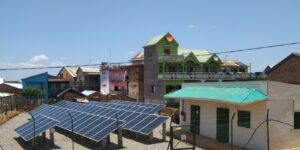Authors : Barès Serena et Berthelemy Jean-Claude
Current evaluations of decentralised electrification projects are generally unable to prove their impact, and to do so would require costly and time-consuming work requiring extensive and detailed information not only in the localities equipped but also in control localities. However, evidence of impact is essential to help public decision-makers, both national and sometimes international, to scale up these solutions.
In four articles for Entreprenante Afrique, we present Electriciens sans frontières’ Cafés Lumière in Madagascar and compare the results of different alternative evaluation methods carried out at affordable cost to test and assess the existence of positive impacts of the project on sustainable development objectives. In this second section, we explore the possibility of testing the presence of impacts using remote sensing data, which is generally inexpensive to mobilise.
The contribution of remote sensing to impact analysis
Remote sensing is based on satellite imagery available at very fine levels of granularity over almost the entire globe and accessible almost in real time and at low cost for a number of measurable terrestrial phenomena of significance for studying human activities. As far as the impact of electrification projects is concerned, satellite imagery measurements of night-time luminosity can be used for impact studies, once experience has been gained in interpreting these data. It has been repeatedly shown that the increase in night-time luminosity is a good correlate of the progress of electrification over time, including at fine levels of granularity (see Berthélemy, 2022, in The Conversation). It is even considered that the increase in night-time luminosity is a reflection of the growth in economic activity (Hu and Yao, 2022).
However, critics of this new approach, which uses observations of natural phenomena that are partially correlated with the consequences of human activities, point to the risk of assessment bias. In our case, night-time luminosity, by definition, measures the light produced at night by lighting, particularly public lighting, but has no direct relationship with total electricity consumption, of which it generally represents a small fraction, and even less with its effects on socio-economic development. While public lighting could have an impact on safety, and therefore also on economic activity, it can only reflect a fraction of the consequences of electrification on human activities.
Application: the Cafés Lumière mini-networks will have a significant impact from 2021 onwards
Night-time luminosity means that the impact of electrification can be detected almost in real time. To illustrate this point, we calculated the average annual night-time luminosity for the 6 equipped localities and for 6 comparable but non-equipped localities, chosen by Electriciens sans frontières by drawing lots to form a treatment group and a control group.
The data was analysed taking into account the following constraints:
– The different localities were not equipped at the same time;
– The Cafés Lumière were set up gradually, with priority given to installing the shop before the mini-network was commissioned. Since the shop has little effect on light emission, it is by testing the effect of the mini-grid that we can first test the impact of the Cafés Lumière;
– The public lighting supplied by the mini-grid is in operation at the times when the satellite passes by (between 0h and 2h in the morning in our case) in only 2 localities: Ambatonikolahy and Talata Dondona.

Figure 1 shows a parallel trend in the average night-time brightness of the 6 equipped villages and the 6 control villages up to 2020, with the first group performing better in 2021 and 2022. The difference is around 10% compared with previous data, which is not very high given the low initial level, but is statistically very significant. Our conclusion from Figure 1 is confirmed by a formally more rigorous statistical test, which uses monthly data by locality, controlling for the effects of seasonality and fixed effects specific to each treated or untreated locality. The implementation of the mini-network leads to an increase in night-time luminosity comparable to that shown in Figure 1 and statistically very significant.
Fears of bias due to the presence of public lighting are only potentially justified in the case of 2 localities out of 6 (Ambatonikolahy and Talata Dondonna). These fears are not entirely justified. In fact, when we try to take into account the presence of the mini-grid and public lighting together, the latter has no significant effect. Furthermore, when the same model is estimated excluding these 2 localities, the results obtained, in terms of the significance of the impact of the mini-grids, do not change.
Public lighting does not have a significant effect in our tests, but this only means that we cannot demonstrate that it does, which may be due to the low power of the statistical tests used. Moreover, bias may exist at Ambatonikolahy and Talata Dondona.
We used data from the operator Anka, which reports the various components of electricity consumption month by month, separating consumption for public lighting from other electricity consumption, bearing in mind that public lighting creates much more radiance, and therefore night-time luminosity, than other electricity consumption. This property is amply verified in our data, and this allows us to calculate an order of magnitude of the bias contained in the data for assessing access to electricity in the presence of public lighting in the middle of the night. For Ambatonikolahy and Talata Dondona, this bias is of the order of 40% in a full year (2022). It is therefore advisable, where possible, to mobilise additional data to assess the impact of mini-grids, which we will do in future editions of this blog.



